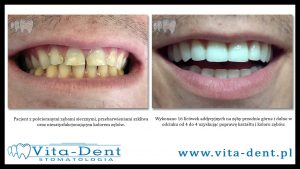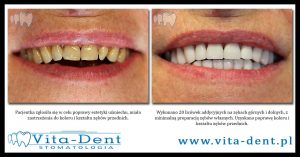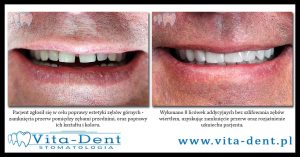Additive veneers
Porcelain
additive veneers are the ideal solution to improve the appearance, color or shape of teeth. Their advantage is that unlike traditional porcelain veneers do not even require minimal preparation of their own tooth tissues. Thanks to this, the teeth under the veneers remain fully healthy and are not damaged during grinding. If necessary, you can always restore the earlier state of your teeth. The additive veneers are made entirely of porcelain – it is a thin porcelain petal with a thickness of just 0.1~0.2mm glued to the enamel of the tooth from its outer, veneal surface – hence the name of the veneers. What is the course of treatment? Here is a simplified scheme:
- First visit: During a conversation with the patient, the dentist learns about his expectations regarding the shape and color of teeth and presents possible options for improving the aesthetics of the smile. After qualifying the patient for the execution of additive veneers, the dentist draws a squeeze to design the future shape of the teeth and perform trial veneers and refers him to the prosthetic laboratory.
- Second visit: the dentist tries on the test porcelain veneers in the patient's mouth and, after accepting the appearance and shape, sends the model back to the laboratory to make the final porcelain veneers
- Third visit: the dentist checks the fit of the porcelain veneers in the patient's mouth and cements them permanently. The patient leaves the office with the coffers attached.
Faqs:
- What are the indications for additive veneers? – indications for the use of veneers are:
- slight tooth discoloration
- glazed and dentin underdevelopment
- unsightly filling of the front teeth
- small loss of hard tooth tissues
- diagnostics and jitters between the sieve teeth
- unacceptable shape of the front teeth by the patient.
- Are there any contraindications to additive veneers? – Yes, contraindication to the use of any type of veneers is teeth grinding, some malocclusion and poor oral hygiene. Veneers are also not performed on dead teeth, after root canal treatment and on teeth with large fillings. In such a situation, all-ceramic crowns are the optimal solution.
- Do addition veneers not fall off if the teeth under them are not ground at all? – thanks to the use of special multi-component systems for connecting porcelain of addition veneer with tooth enamel, there is no such risk. The sticky additive can only be removed in the office by destroying and drilling it. The lack of grinding of teeth is one of the advantages of improving the shape of teeth with veneers.
- Are additive veneers or traditional all-ceramic veneers better? – It is difficult to answer which veneers are better, it all depends on the medical indications in a given case. Additive veneers are not suitable for the restoration of large tooth damage, which can be rebuilt with classic porcelain veneers. On the other hand, if it is possible to improve the shape and appearance of the tooth without grinding, then the additives in such a situation will work better than traditional full-ceramic veneers.
 16 addition veneers – upper and lower
16 addition veneers – upper and lower 20 top and bottom addition veneers
20 top and bottom addition veneers Closing the diastema with additive veneers
Closing the diastema with additive veneers